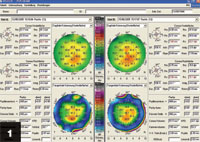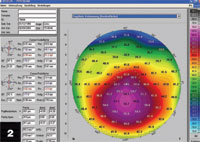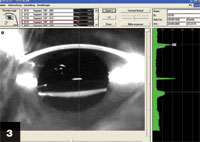Over time, multiple uses found for diagnostic tool
A clinician has come to rely on the Pentacam system for anterior segment measurement tasks.
Click Here to Manage Email Alerts
After 3 years using the Oculus Inc. Pentacam in his office, one clinician says he has found numerous uses for the diagnostic device in his cataract and refractive surgery patients.
Tobias Neuhann, MD, said he employs the system almost immediately when patients come through the door of his clinic in Munich, Germany.
“Every patient who comes for a checkup in the office gets a Pentacam. Every patient who comes with a question on refractive surgery gets a Pentacam,” he told Ocular Surgery News. “It’s a beautiful additive tool to give you a lot of information with one examination.”
According to Dr. Neuhann, the Pentacam system measures corneal power precisely, allowing him to calculate IOL power for patients after refractive surgery. The camera also allows the clinician to assess the stage of a patient’s cataract and numerous other anterior segment measurement tasks.
Scheimpflug principle
The Pentacam system contains a rotating Scheimpflug camera that can create a precise, three-dimensional view of the anterior segment including the central cornea.
Dr. Neuhann said other imaging systems, such as the Bausch & Lomb Orbscan topographer, have a blind spot in the center of the cornea, so the resulting map of the central cornea is calculated based on surrounding pericentral measurement.
But the Scheimpflug camera takes direct measurements of the central cornea, “which is one of the most interesting parts of the cornea,” Dr. Neuhann said.
The Pentacam measures the anterior and posterior surfaces of the cornea by taking 50 single slit images in 2 seconds while it rotates around the eye from 0° to 180°.
The system evaluates 500 measurement points from each slit image, totaling 25,000 true elevation points that create an exact 3-D image of the anterior segment, Dr. Neuhann said.
The device has two cameras, one in the center for controlling fixation, and one mounted on a rotating wheel to capture the slit images.
|
|
|
|
|
|
|
|
|
|
|
|
| Images: Neuhann T | |
Clinical examples
Dr. Neuhann described recent cases in which the device was helpful.
“Today we had a patient from Canada here in Munich. He had LASIK years ago, so in Germany we have absolutely no information about his LASIK surgery, and he had a huge cataract,” he said.
The Pentacam system was able to acquire all the necessary information about the anterior segment to allow the clinician to calculate the proper IOL power, Dr. Neuhann said, without having any information about the previous refractive surgery.
“In a normal patient, IOL calculation is not a big thing, but it’s a real big thing when the patient had corneal refractive surgery; it’s difficult to calculate that. But the Pentacam gives you the true power of the cornea in the center,” he said.
He described another case of a patient who had a corneal transplant due to keratoconus. The Pentacam revealed potential astigmatism problems when the patient came in for suture removal.
“Normally after 1 year we remove one running suture, and 6 weeks later we remove the second suture,” Dr. Neuhann said. “When he came in for the second suture, I used the Pentacam just to get some information about his cornea, and I saw in the periphery some ‘hot spots’ in the cornea, so I decided not to remove the suture. This patient did not have a very high astigmatism with the second suture in place, and if I removed it he would’ve gotten very high astigmatism. So I said, keep your suture. That was the first time I had motivation to tell a patient to keep a suture for the next 2 or 3 years.”
In another instance, Dr. Neuhann encountered a patient who had previously had LASIK for high myopia and now needed an IOL implant. The patient’s keratometry showed an unusual central corneal power of 19.2 D.
“Formerly he had 42 D, and now he had 19 D, so you don’t believe [the measurement],” Dr. Neuhann said. “I told him that in most cases, we do the cataract surgery, and we have to change the IOL a week after the surgery because it’s a false positive result. In this patient, I put this 19.2 D in the formula, and it was a little less than 1 D off the intended refraction, which was fabulous,” he said.
Dr. Neuhann said the Pentacam can also be used to assess a patient’s IOP in relation to corneal thickness, and he explained that it is particularly useful for follow-up assessments of patients with phakic IOLs in place.
“You can lean back in your chair and you just look to the picture, and you can talk to the patient with that. It’s a very helpful tool. It’s simple, the patient won’t complain about it, and it’s very accurate,” he said.
For Your Information:
- Tobias Neuhann, MD, can be reached at Marienplatz 18/19, Munich 80331, Germany; +49-89-23-08-89-0; fax: +49-89-23-08-89-10; e-mail: sekretariat@a-a-m.de. Dr. Neuhann has no direct financial interest in the products mentioned in this article, nor is he a paid consultant for any companies mentioned.
- Oculus Inc., maker of the Pentacam, can be reached at Muenchholzhaeuser Str. 29; D-35582 Wetzlar, Germany; +49-641-2005-0; fax: +49-641-2005-295; Web site: www.oculus.de.
- Jared Schultz is an OSN Staff Writer who covers all aspects of ophthalmology. He focuses geographically on Europe and the Asia-Pacific region.








